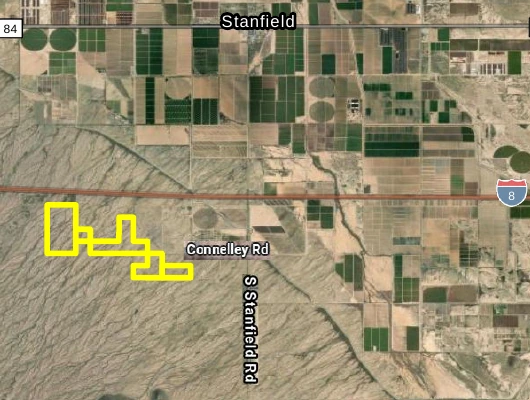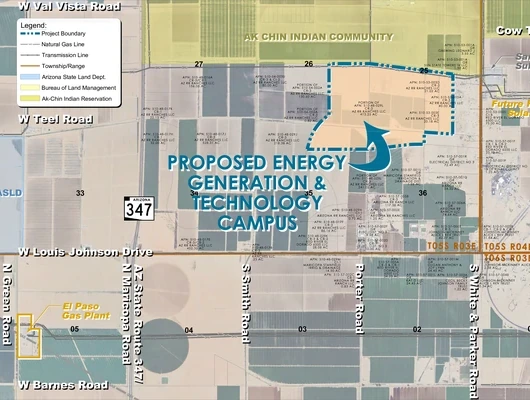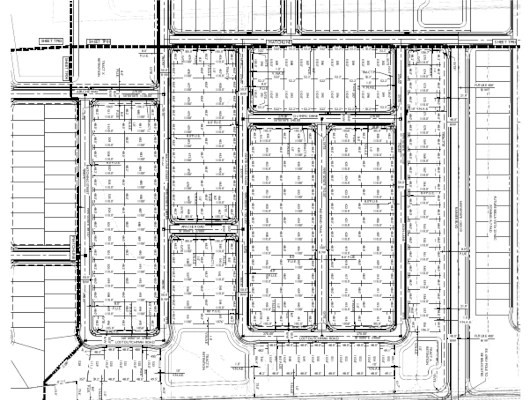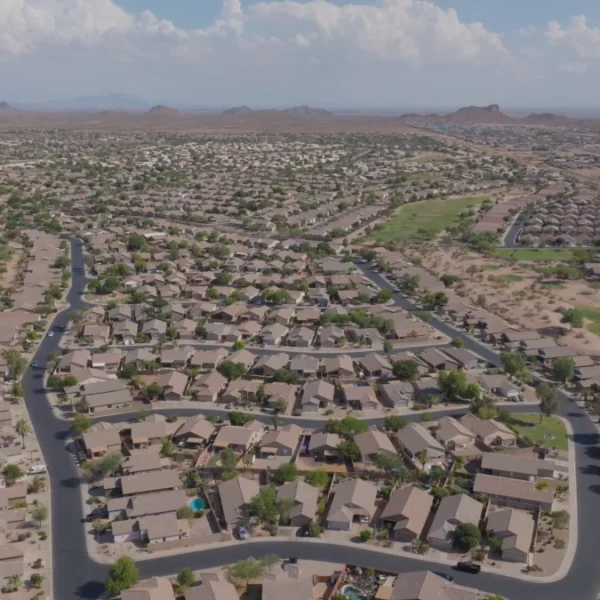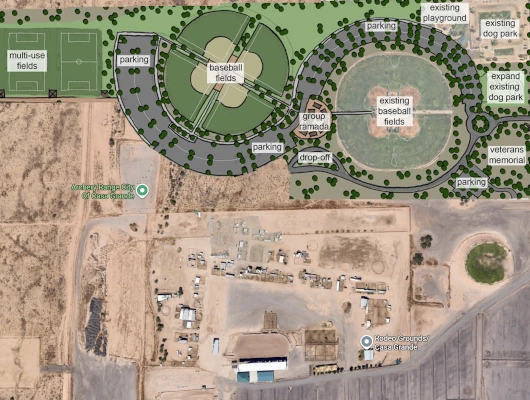The Pinal County Board of Supervisors voted 5-0 on November 19, 2025, to approve the Project Midway Data Center comprehensive plan amendment. The 215-acre development near Casa Grande cleared a major hurdle after unanimous votes from the Citizens Advisory Committee (15-0) and Planning and Zoning Commission (9-0).
Project Midway Data Center Proposal Details
The comprehensive plan amendment changes 215 acres from Moderate Low Density Residential to Employment. Developer LPI Group plans to build a data center campus on the property at the southwest corner of Selma Highway and Midway Road. The site sits south of Casa Grande and north of Interstate 8. The property falls within Casa Grande’s extended planning area.
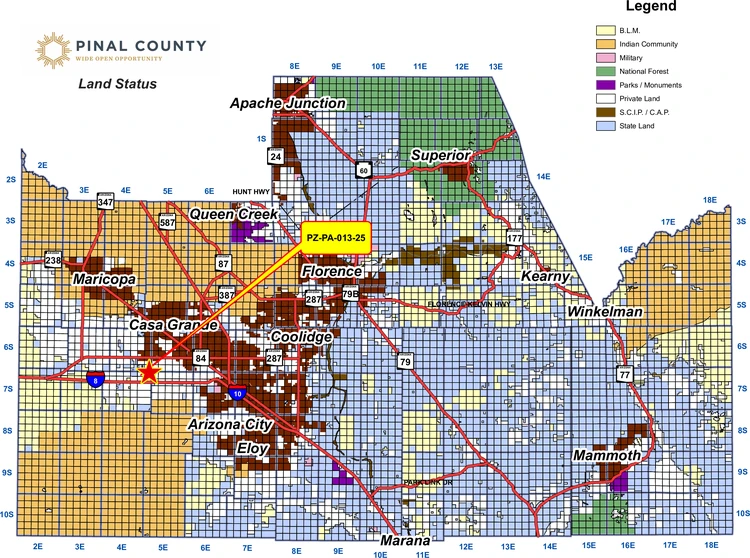
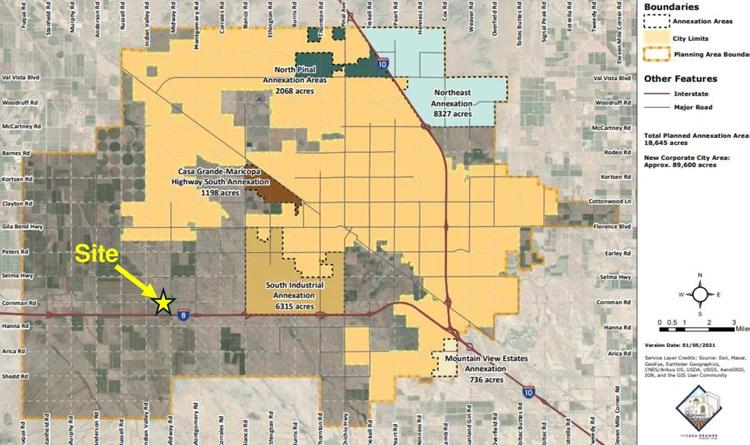
Withey Morris Baugh PLC represented the property owner, Selma & Midway LLC. Alex Hayes presented the proposal to the supervisors. He described the anticipated development area as about 70 acres on the north side of the property. A 10-acre substation would sit between the data center buildings and Project Bella to the south.
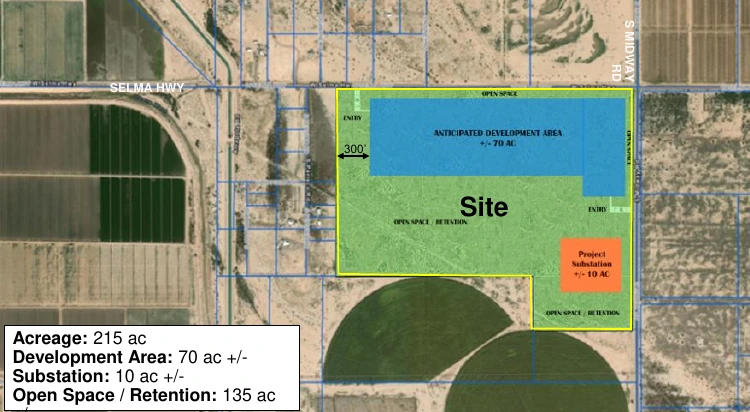
Project Bella is a separate development. The natural gas power generation and battery storage facility received approval in 2025. It sits directly south of the Project Midway site but is not part of this proposal.
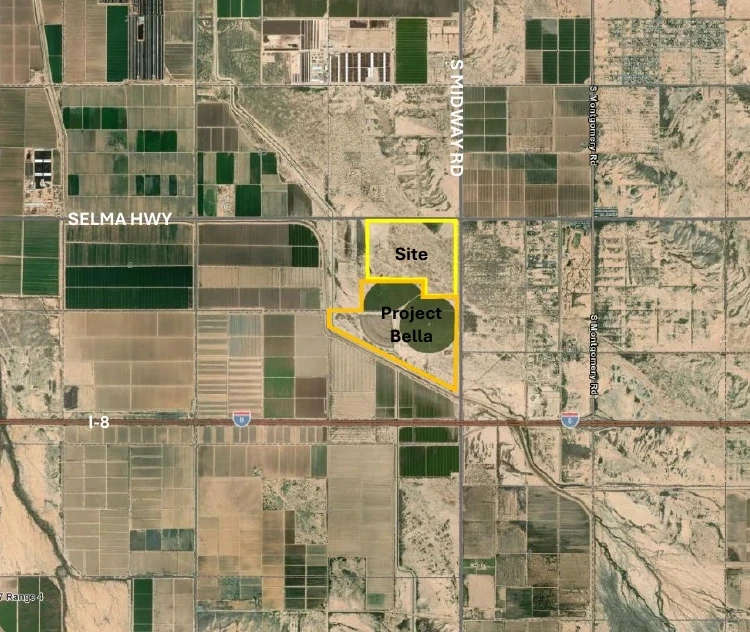
An El Paso Natural Gas easement bisects the Project Midway property diagonally.
The surrounding area remains largely rural. Vacant desert land and agricultural properties sit to the south and west. North and east of the property lie undeveloped land and some residential parcels. Existing 500kV and 230kV transmission lines run through the immediate vicinity.
The project aligns with an emerging industrial pattern along Interstate 8 south of Casa Grande. Casa Grande’s general plan envisions this corridor for industrial and manufacturing growth. Several other energy and employment projects have received recent approvals in the same area.

Powering the Data Center
Power supply dominated the discussion. Hayes emphasized a key point about the project’s electrical requirements.
“This project would be required to bring its own power, so it wouldn’t be encumbering any of the existing capacity there at ED3, and it would be required to fund any necessary upgrades to the transmission and distribution infrastructure,” Hayes said.
Hayes also addressed the question of power sources.
“As it relates to the specific sources of power, we have no contract for power from any particular source, but we’ll be studying all the different potential options, including the potential for onsite generation, if that is feasible,” Hayes said.
Earlier presentations outlined a conceptual power mix with specific percentages from Project Bella and other sources. Hayes clarified that no contracts exist yet. Engineering studies and coordination with ED3 remain ongoing. The project sits within ED3’s service territory.
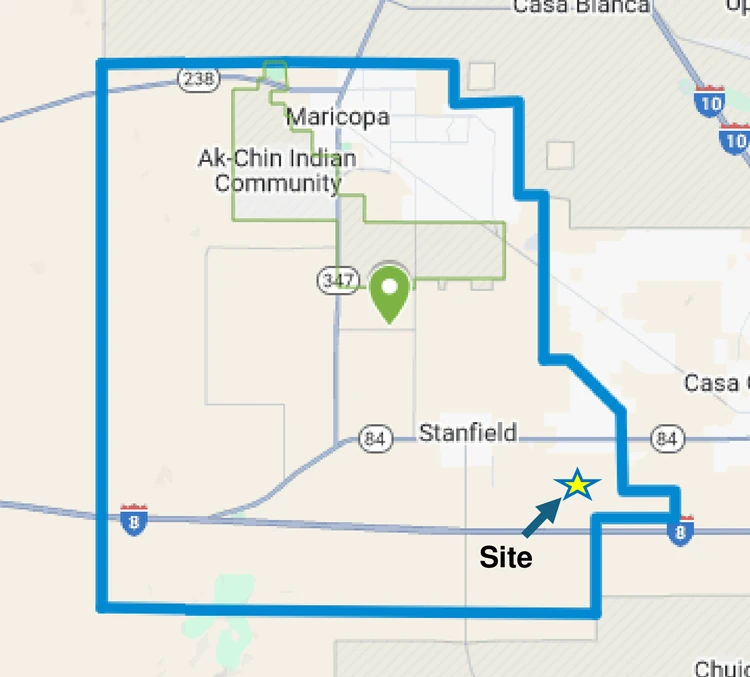
Vitiello pressed Hayes on ED3 discussions. “I’d like to know where the discussions have actually gone and how long these discussions have been going on,” Vitiello said. “You know as well as I do, Project Bella is not powering this and I got a real problem with power there.”
Hayes responded that the Project Midway team has had in-person discussions with ED3. However, no load impact study has been completed at this entitlement phase.
Economic Impact and Jobs
Hayes presented an economic impact study with updated figures. The project represents a $6.6 billion capital investment. It would create about 225 permanent jobs with an average salary of $93,000 per year. Hayes noted this is roughly twice the average salary in Pinal County.
According to the study, company tax revenues to Pinal County would reach $127 million over the project’s 20-year life. Schools and special districts would receive $91 million. Annual utility expenditures at full build-out would reach $150 million.
Hayes said the construction phase would generate “hundreds if not thousands” of jobs. Hayes said data center equipment typically gets replaced every three to four years as technology advances, creating ongoing construction activity.
Fire Service Expansion
The project area currently lacks fire service. Hayes explained that Project Midway would coordinate with Chief Heaton to establish fire service through the Pinal County Fire and Medical Authority. This authority would extend the boundaries of the Arizona City Fire District.
Vitiello asked specifically about funding commitments. “I saw none of that here, which is very important to me because Project Bella is gonna be funding that fire station for the most part,” he said.
Hayes acknowledged the concern. “As you probably recall from Project Bella when we were on the major comprehensive plan phase, we didn’t have those numbers either,” he said. “We’ll continue to work with Chief Heaton to have a contract. By the time we’re back for you for zoning, we would have some more specificity on what that looks like and what the contributions would be.”
Chairman Stephen Miller discussed possible funding approaches. One approach would expand the fire district, with property taxes funding the service. Another option would use a subscription model with annual payments. Hayes said the goal is initial funding to get the Fire Authority established, then transition to ongoing assessment-based funding.
Hayes noted that area residents currently pay high costs because they lack fire coverage. “We heard from a property owner nearby who pays an additional $5,000 a year in property insurance because he doesn’t have fire service,” Hayes said.
Water and Cooling Technology
The project would use air-cooled or closed-loop cooling systems. This significantly reduces water consumption compared to water-cooled facilities common in other regions. Hayes estimated water use at about 4.2 million gallons per year, roughly 13 acre-feet annually.
Hayes said data center operators comfortable with low-water environments use air-cooled or closed-loop systems. He offered to stipulate to these technologies at the zoning phase.
Arizona Water Company would likely provide potable water for the project.
Public Comments and Concerns
Hidden Valley residents addressed the supervisors. Maryeileen Flanagan asked for stipulations on water and power.
“If it goes in, it needs to be stipulated that it will never draw on our water supply or aquifer,” Flanagan said. She noted that one of her neighbors had drilled her well deeper three times in six months because of aquifer issues.
Flanagan also raised concerns about the electrical grid. “Just today, we had a power outage,” she said. “While we were on our way here, I got a notification on my phone that we had power outage at my house again. And this is not an unusual thing to have happen for no particular reason. It’s just the grid goes down and the grid comes back.”
She asked for berms or soundproofing. “In the desert, especially at night, sound travels,” Flanagan said. “You can hear your neighbor talking across the street and they’re talking in a normal voice.”
Robin Davis attended the Citizens Advisory Committee and Planning and Zoning Commission meetings. She raised concerns about power discussed at those earlier hearings. “They are pulling from ED3. How does that affect the customers? How does it, that affect us?” Davis asked.
Davis also mentioned the power outage. “Like Maryeileen said, I got the notification as well, we had an outage and then it returned,” she said. “That’s normal.”
She concluded with a request. “I’m not really opposed to it but I wanna make sure that stipulations, strict stipulations are put in,” Davis said. “If this goes forward, it goes back around to Planning and Zoning, and that’s where they get the stipulations, that these do not place a hardship on the local residents.”
Applicant’s Response to Public Comments
Hayes addressed specific concerns raised by residents. On water usage, he clarified the difference between water-cooled and air-cooled facilities.
“As it relates to the water, yes, data centers can use that much water and they do when there’s abundant water,” Hayes said. “Places like the Northwest or the Southeast, where there is an abundant amount of water, then water cooling makes sense. But in places like the desert Southwest, it doesn’t make sense to use that much water and they’ll use an air-cooler or a closed-loop system.”
He offered to formalize this commitment. “We’d be happy to stipulate to that at the zoning phase,” Hayes said.
Vitiello relayed Flanagan’s noise concern to Hayes. “This is inside of a building, so everything is internal, correct?” he asked.
Hayes confirmed that sound comes from backup generators and cooling systems. “We’ll do sound studies and are happy to work on any sound mitigation measures,” he said. “Under no circumstances are we gonna be exceeding the noise limits of the ordinance. Through our sound studies, we’ll look at ways to mitigate the sound to the extent possible and happy to stipulate to that as well.”
Vitiello then asked about screening. “And then, as in Project Bella with those big, beautiful walls, you would be happy to give me that around this data center, correct?”
“I think we’d be happy to work with you on the solution that makes the most sense,” Hayes replied. “If it’s a wall, then it’s a wall, but if there are other options that are maybe better for everybody than a wall, we would like to pursue those options too.”
Opposition and Community Feedback
Staff received one written letter of opposition before the hearing. Deanna Pence lives on Selma Highway near the project. She expressed concern about water, light pollution, noise, and rural character.
“We have lived here for nineteen years and we moved here for the rural ranch style living,” Pence wrote. “That style of living in Pinal county is rapidly being eroded and it feels like the people living here have no voice.”
The applicant’s neighborhood meeting in May 2025 drew nine attendees. Several attendees supported the proposal and its potential economic benefits. Others expressed a desire to preserve rural character.
Rezoning Phase Ahead
The comprehensive plan amendment allows the developer to begin the rezoning process. The applicant must return to the Planning and Zoning Commission and Board of Supervisors for zoning approval.
At the zoning phase, the commission and board will address specific stipulations. These may include commitments to air cooling, sound mitigation measures, buffering requirements, and coordination with ED3. Hayes said he expects to have more details on fire service contracts and funding by the zoning phase.
Hayes indicated that more engineering studies and ED3 coordination will occur before the next phase.
Previous Coverage
For more background on this project, see Midway Data Center Gets Unanimous Approval as Power and ED3 Questions Emerge and Data Center Proposal Near Casa Grande Reviewed by Commission.
Editor’s Note (November 24, 2025): Earlier county filings identified IDM Companies as the applicant for Project Midway. A representative has since clarified that LPI Group is the correct applicant, and county documents are expected to be updated to reflect this. As of this date, official planning materials still list IDM Companies.

